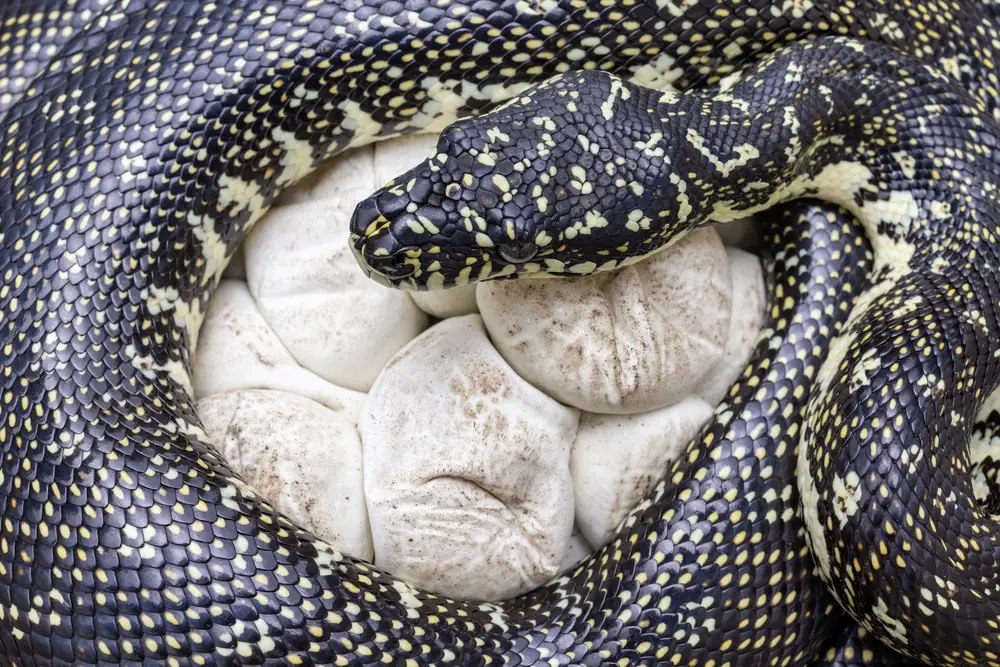Snake eggs hatch in much the same way as birds. Their shells are leathery, however, so the babies make long slits in the shell rather than crack it to emerge…
Just like birds, baby snakes use an egg tooth to cut their way out of their eggs when they have finished absorbing their yolk. After making a few slits in the leathery shell, they slowly emerge. The whole process takes anywhere from a few minutes to as long as a couple of days.
In this article, we’ll take a look at how snake eggs hatch, how many are laid, how long they take to hatch, and a range of other egg-related facts.
How do snakes lay eggs?
Snakes lay eggs much like other reptiles. They typically find a warm, sheltered location, such as under leaves or logs, to deposit their eggs. After selecting an appropriate nesting site, the female snake lays her eggs and leaves them.
Depending on the snake species and the clutch size, this process can take a few hours to several days. The eggs typically hatch after an incubation period of around two months but can range anywhere from a few weeks to several months.
When hatching, baby snakes must use special egg teeth to slice out of their tough shells and reach the outside world. After breaking out of their eggs, they are on their own and must fend for themselves.
Many snakes are egg-laying reptiles, but hatch from leathery eggs, unlike other animals that lay eggs with a hard shell. This adaptation is meant to help keep the egg moist during incubation by allowing it to absorb water from its surroundings.
Leathery eggs may also protect from invertebrate predators, and parasites such as bacteria or fungi.
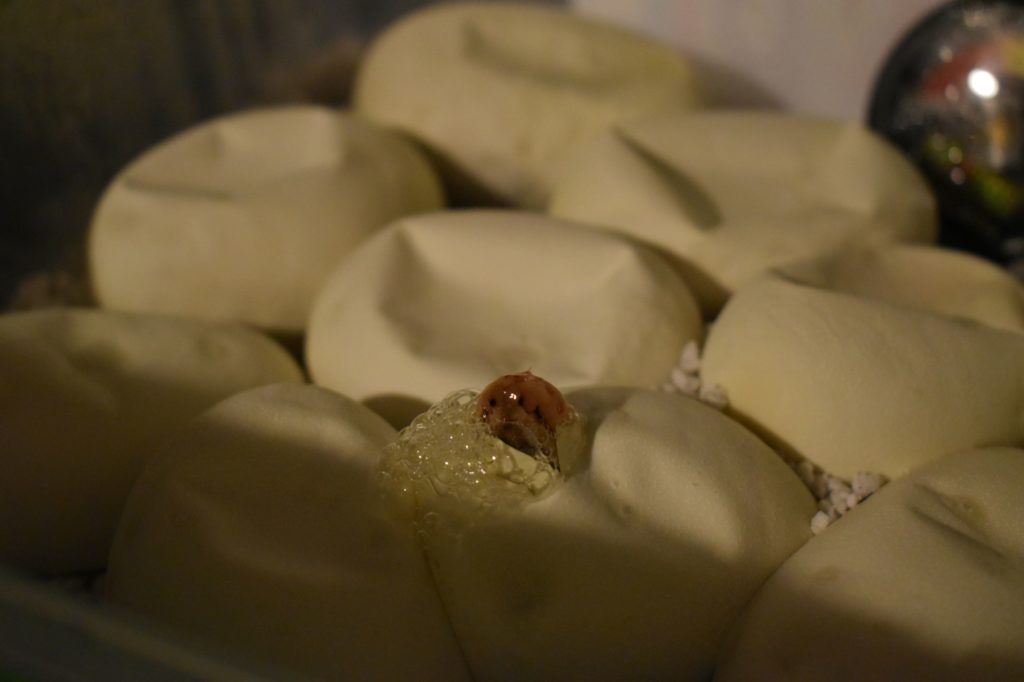
How long does a snake egg take to hatch?
The answer to this question is flexible, as the exact amount of time it takes for a snake egg to hatch depends on various factors. Generally speaking, the species and size of the snake can play a role in determining how long it will take for an egg to hatch.
Additionally, the temperature and humidity levels of the environment can also play a role in the hatching time of a snake egg. Most snakes take between three and twelve weeks for their eggs to hatch.
The exact amount of time depends on the particular species and environmental conditions. Regardless of the type or size of the snake, it is important to provide optimal temperatures and humidity levels for successful hatching.
For example, Ball Python eggs hatch after about 58 days at a temperature of 89F and a humidity level of 90%+. Deviate too far from these parameters and they’ll hatch sooner, later, or not at all.
Other snakes have different parameters for incubation. Corn Snakes, like the one below, will hatch after 58 days at 84F. They can also tolerate much more variation in their incubation temperatures than most pythons.
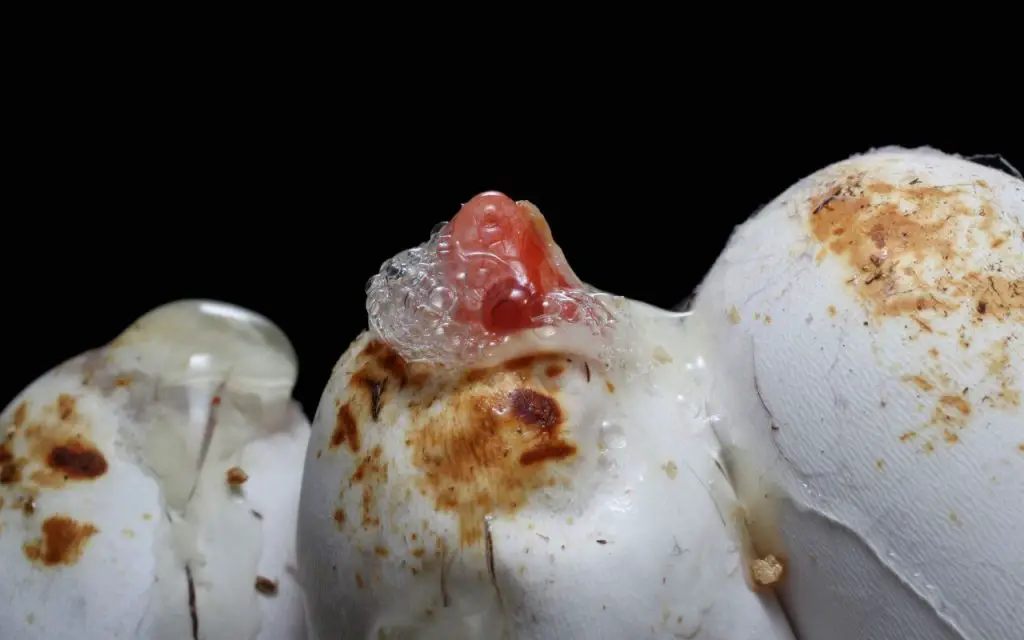
How many eggs does a snake lay?
Hundreds of snake species are oviparous, meaning they lay eggs instead of giving birth to live young. The number of eggs produced depends on the species of snake and how large it is.
Small snakes, such as Green Snakes, typically lay between 2-6 eggs at a time, while larger species, like the Reticulated Python, can produce up to 100 eggs in a single clutch.
Female snakes will often lay several clutches of eggs during their breeding seasons, laying anywhere from 5-20 eggs each time.
After the eggs are laid, they hatch in an incubation period of 2-3 months. The temperature and humidity levels during this period need to pretty constant, though. Otherwise some or all of the babies will perish before hatching.
Take a look at the table below for examples of oviparous snake species and their average clutch sizes:
| Snake Species | Number of Eggs |
|---|---|
| Reticulated Python (Python reticulatus) | 20-100 |
| Burmese Python (Python bivittatus) | 20-80 |
| African Rock Python (Python sebae) | 20-50 |
| Corn Snake (Pantherophis guttatus) | 8-20 |
| King Snake (Lampropeltis getula) | 6-24 |
| Rat Snake (Pantherophis obsoletus) | 6-30 |
| Black Racer (Coluber constrictor) | 8-20 |
| Milksnake (Lampropeltis triangulum) | 4-15 |
| Coachwhip (Masticophis flagellum) | 8-20 |
| Eastern Hognose Snake (Heterodon platirhinos) | 4-24 |
| Western Hognose Snake (Heterodon nasicus) | 4-15 |
| Green Tree Python (Morelia viridis) | 12-30 |
| Ball Python (Python regius) | 4-12 |
| Pine Snake (Pituophis melanoleucus) | 6-20 |
| Great Basin Gopher Snake (Pituophis catenifer deserticola) | 4-12 |
| Grey Ratsnake (Pantherophis spiloides) | 6-20 |
| Rainbow Snake (Farancia erytrogramma) | 20-30 |
| Eastern Indigo Snake (Drymarchon couperi) | 5-25 |
| Rough Green Snake (Opheodrys aestivus) | 2-5 |
| Smooth Green Snake (Opheodrys vernalis) | 2-6 |
| Ground Snake (Sonora semiannulata) | 3-10 |
| New Mexico Whipsnake (Masticophis taeniatus) | 6-10 |
| Gray-banded Kingsnake (Lampropeltis alterna) | 4-12 |
| Black Kingsnake (Lampropeltis nigra) | 4-20 |
| Desert Kingsnake (Lampropeltis getula splendida) | 4-20 |
| Speckled Kingsnake (Lampropeltis holbrooki) | 4-12 |
| Mexican Pine Snake (Pituophis deppei) | 6-12 |

Do snakes stay with their eggs until they hatch?
Most snakes do not stay with their eggs until they hatch. Instead, female snakes lay their eggs in a safe place, leaving them alone to develop. In some cases, snakes may remain nearby for a short period or even coil up around the eggs to keep them warm.
However, this is not true for all species of snakes, and some may exhibit more maternal behavior and guard their eggs until they hatch. This behavior is usually seen in larger snakes, such as pythons, which can stay with the eggs for longer periods of time.
Additionally, some snakes will lay their eggs in communal nests and remain with them until all of the eggs have hatched. It is important to note that, regardless of the species, snakes rarely protect their eggs in a traditional sense, as they cannot recognize them or provide nourishment.
Therefore, it is best to assume that most snakes leave their eggs shortly after laying them and do not stay with them until they hatch.
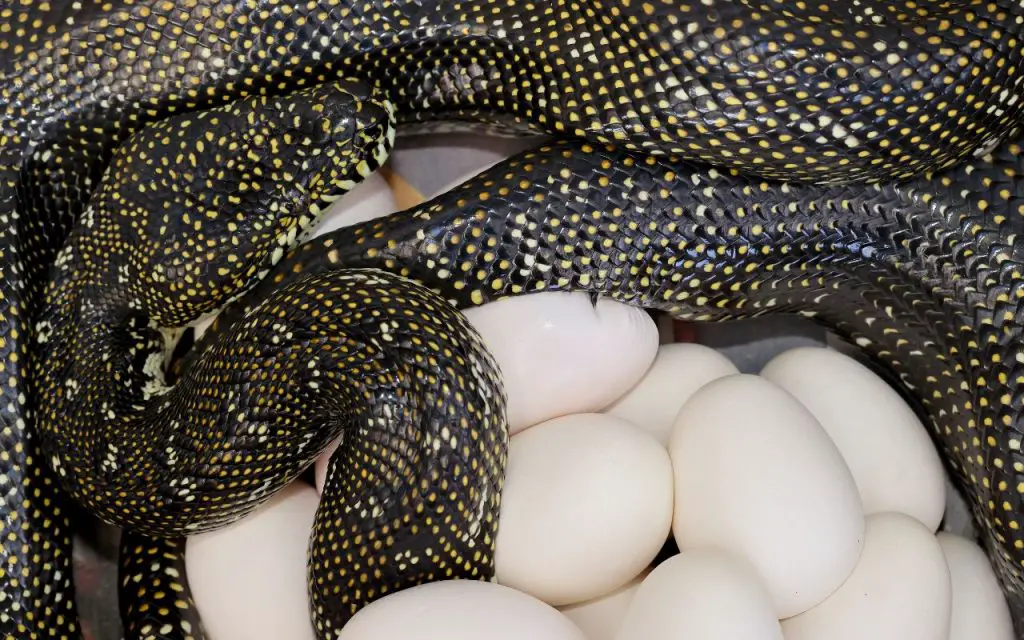
How many eggs does a snake lay in a day?
Snakes typically lay between one and twenty eggs in a single clutch. Female snakes can sometimes lay over 50 eggs per clutch, depending on the species. The number of eggs varies greatly depending on the snake’s size and reproductive cycle. Some snakes may even lay multiple clutches of eggs over one year.
Most snakes lay eggs in the wild. However, some species of snakes can give birth to live young. While it is unknown how many eggs a snake can lay in one day, each clutch would likely be laid over several hours and be finished within 24hrs. Last time I watched one of my Ball Pythons lay eggs, it took her 6 hours to lay 11 eggs.
In general, larger snakes tend to lay more eggs than smaller snakes. The eggs are usually deposited in a safe and secure location, such as under logs or rocks, where they can develop until they hatch.
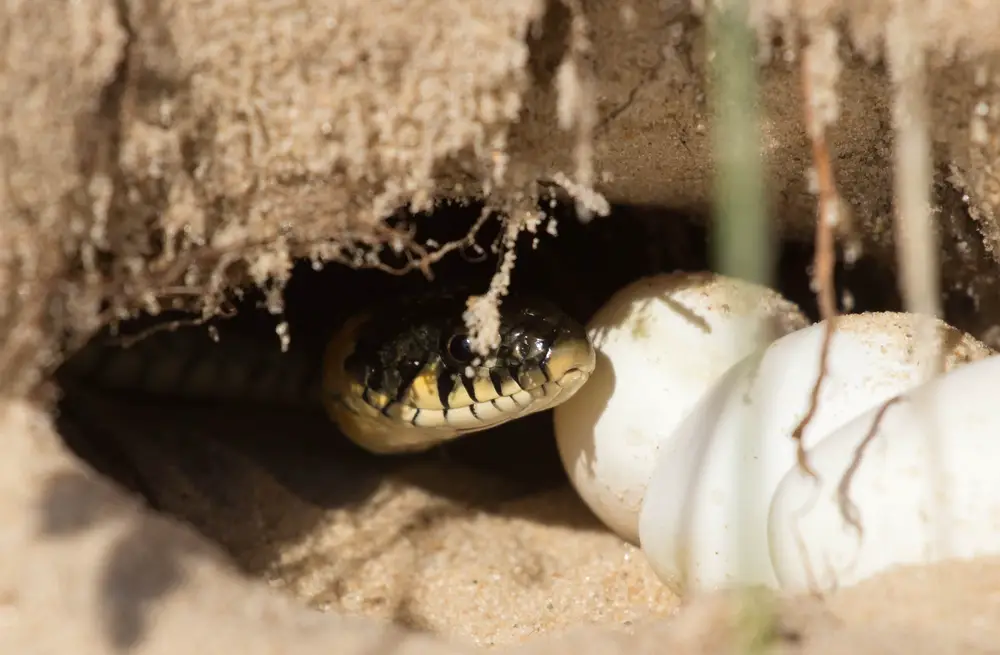
What happens when snake eggs hatch?
When a snake egg hatches, the young snake slices its way through the membrane and shell of the egg with its egg tooth. It then takes around a week for its body to absorb the residual yolk before it can start hunting. (*the yolk inside its body – the yolk outside is absorbed before hatching)
During this period, baby snakes are vulnerable and need shelter until they can fend for themselves. Newly hatched snakes may also look for food near their egg site, as they already seldom stray far before their first shed.
Depending on the species, newly hatched snakes will either stay with their siblings for around a week, or venture out alone right away. The young snakes can take up to four years before reaching full size and sexual maturity.
During this period, baby snakes must develop self-defense mechanisms, foraging skills, and the ability to find prey. Once mature, snakes can live between 10 and 30 years in the wild.
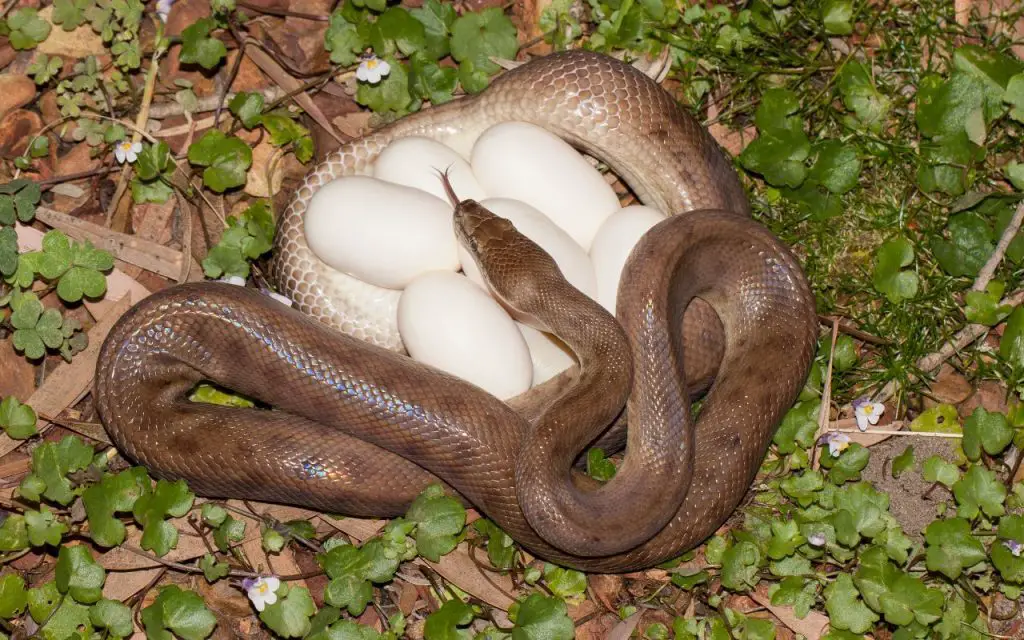
Snakes laying eggs in a variety of shapes and sizes
Although many of the common species you see around your propery are live-bearing (viviparous/ovoviviparous), such as Garter Snakes, most species of snakes around the world are egg-laying (oviparous).
This means snake eggs come in a huge variety of shapes, sizes, and appearances. The majority are white and oval, but some are lumpy, patchy, elongated, spherical, or granular.
What they all have in common, however, is their leathery shell, referred to by herpetologists as parchment shell. This is actually a great way of telling snake eggs from some lizard eggs.
How do snakes keep their eggs warm?
Snakes lay their eggs in warm, moist places such as under rocks or in rotting logs that absorb the sun’s heat. This helps keep the eggs warm and free from predators.
Pythons will also coil around their eggs to provide warmth and protection. Some Pythons will bask for a while every few hours to raise their temperature and transfer it to the eggs, whilst others generate heat by shivering their muscles.
In most other species, the mother snake usually abandons the eggs right after laying. The baby snakes are born fully developed and capable of caring for themselves. They make their way in the world without requiring parental care.
So far, we only know of one snake that actually makes a nest for its eggs: the King Cobra (Ophiophagus hannah). This snake makes a mound of vegetation that it lays its eggs in and guards until they hatch. During incubation, the eggs are kept warm by the decomposing plant matter which releases heat.
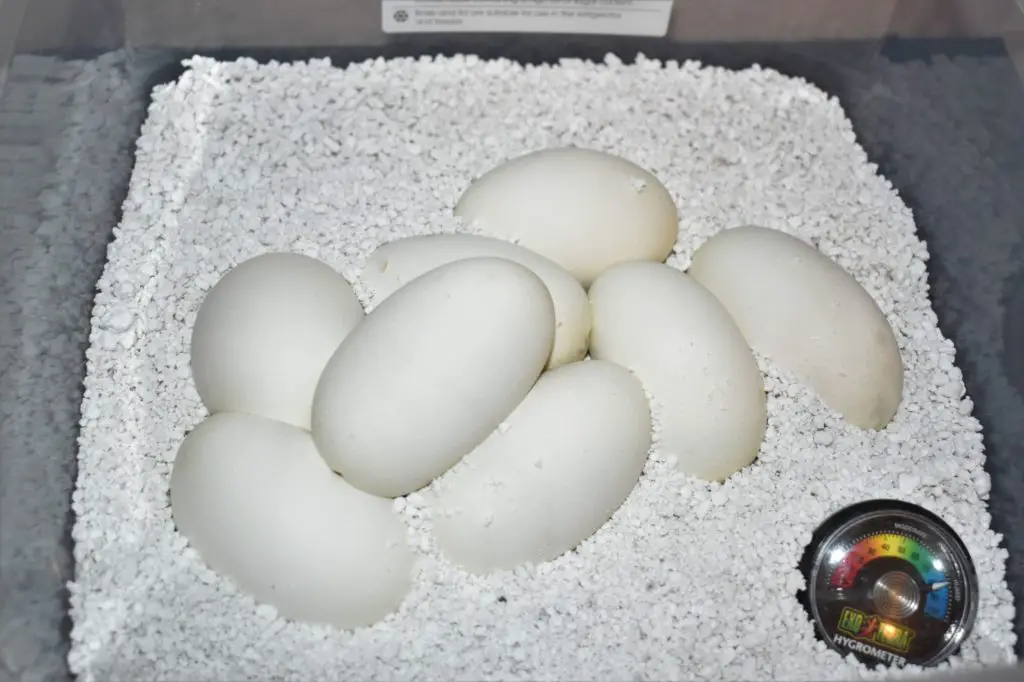
Do snakes feel affection?
Snakes are known to be ‘cold-blooded’ and emotionless, but researchers have found that they can recognise their owners. They also have an innate instinct to protect their eggs, at least during laying.
In some cases, snakes have been observed to come out of hiding to seek contact from humans when they feel comfortable enough in the presence of their owner. Overall, it has to said they don’t show affection, though.
In fact, they probably connect us to feeding time, which explains why intelligent species like the King Cobra will come rushing to the front of their enclosure when they see you.

FAQ relating to how do snake eggs hatch
Can a female snake lay eggs without a male?
Yes, a female snake can lay eggs without a male. This is known as parthenogenesis, a form of asexual reproduction. The process involves the development of an egg by using the mother’s genes rather than combining them with another organism, like in sexual reproduction. It occurs naturally in some species of reptiles, including certain snakes. Occasionally, even Ball Pythons lay eggs without a male.
How long are snakes pregnant?
Gravid snakes typically carry their young or eggs for one to three months, although this can vary depending on the species. Ultimately, it depends on the species, but also on the individual snake and her specific circumstances.
What do unfertilized snake eggs look like?
Unfertilized snake eggs look small, yellow, and waxy. They typically have a smooth surface and feel rubbery to the touch. Also known as slugs, unfertilized eggs are almost always smaller and darker than fertile ones.
Does a female snake eat a male snake after mating?
Female snakes typically do not eat the males after mating. The female snake may be more likely to try and distance itself from the male, as some species of snake can become quite aggressive or persistent during the mating process. For this reason, after copulation, the female may want to get away from the male as quickly as possible.

